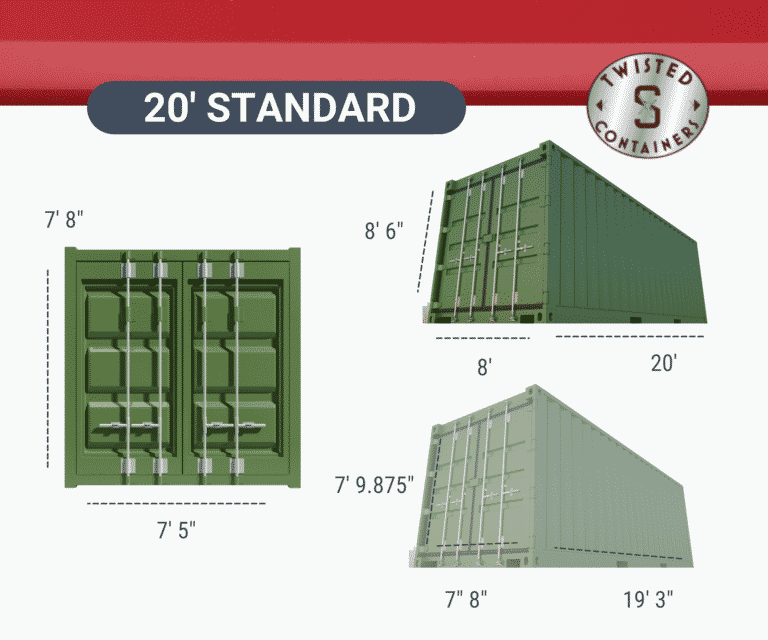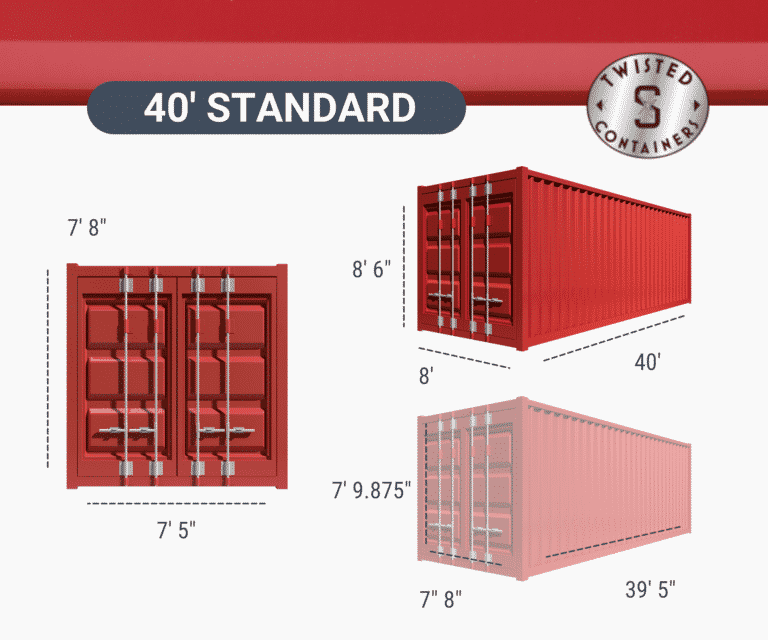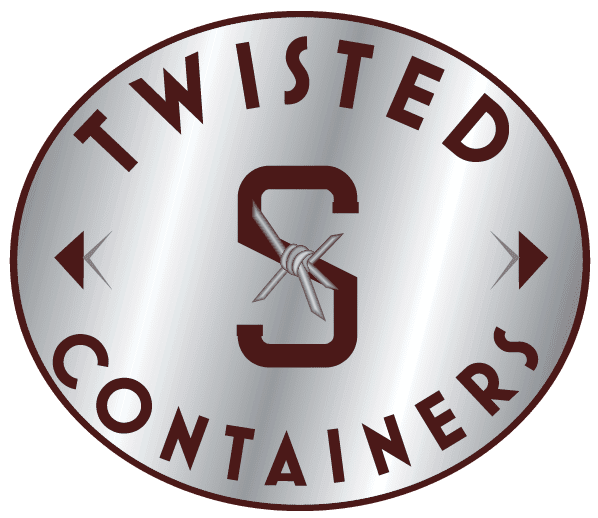Home » Shipping Container Specifications
TWISTED S CONTAINERS
Shipping Container Specifications
Looking for more information about shipping containers? Twisted S Containers can answer your questions and help you solve problems related to shipping containers.
Shipping container dimensions and capacities
It’s important to know what standard shipping container is best for your construction site, small businesses, or any project needing repurposed shipping containers. Not only do you need to plan for your project site and surrounding area, but also for the type of equipment and tools you’ll need to complete the job. In addition, knowing the sizes and dimensions make it that much easier for delivery and use of the container.So, before you start on your portable office or container home, let’s dive into the nitty-gritty of standard containers!
Typical shipping containers, known as ISO (International Standards Organization) shipping containers, are manufactured to identical size specifications, in terms of exterior length, width, and height. Standardized sizes mean that shipping companies can easily stack, handle, and move containers. The standardization of containers and the adoption of the ISO specifications also ensure that all equipment handlers, chassis, rail cars, and slot spaces on vessels can accommodate all containers. Interior shipping container specifications have a little bit of variation, but the difference is within 1 inch.
Using shipping containers as storage units has changed the storage industry. Many prefer the convenience of a mobile storage container vs. standard mini storage container. This guide is designed to help you become informed about typical container sizes and common shipping container storage questions. Be confident in finding the best for your portable storage or overall storage container needs.
GENERAL SHIPPING CONTAINER SIZE FAQS
Shipping containers are 8 feet wide. While they vary in length and height, 8 feet wide is the standard.
Most shipping containers are 8 feet 6 inches tall. However, there is a special subset called high cube shipping containers, which measure 9 feet 6 inches tall. High cube containers are much less common.
Length is where shipping containers vary. They generally vary between 10 and 45 feet long. The most common shipping container lengths are 20 and 40-foot sizes.
While all standardized ISO containers are 8 feet wide, shipping containers vary in length and height. Shipping containers come in several standardized sizes, including 10 foot, 20-foot, 40-foot, and 45-foot lengths. In terms of height, containers are generally 8 feet 6 inches tall, though a special variation, called high cube containers are one foot taller, at 9 foot 6 inches.
Empty, 20-foot standard shipping containers weigh approximately 5,000 pounds while empty 40-foot containers weigh approximately 8,000 pounds. Fully loaded containers weigh approximately 67,000 pounds.
A steel storage container offers quite a bit of space. A 20-foot container can hold the contents of a one- to two-bedroom apartment. Alternatively, that space can fit 200 full-sized mattresses or 50 to 60 refrigerators. A car will fit into a 20-foot container, with room left over for cargo.
20 Foot Shipping Container Dimensions & FAQS

20 foot shipping containers are the standard size container thats compact and affordable. It’s just enough space without being too big for many applications. The dimensions for these shipping containers are 8′ x 8’6″ x 20′ and weigh approximately 5,000 lbs with a max weight capacity of 62,000 lbs. These are often used as extra storage sheds or small, temporary office spaces, as seen on construction sites.
20 Foot Shipping Container FAQs
A 20 foot standard container measures 8 feet wide on the exterior and 7 feet 8 inches wide on the interior.
5,050 pounds empty.
The maximum load that a 20 foot container can carry is 62,150 pounds, for a max gross weight of 67,200 pounds.
20 foot containers are 8 feet wide by 8 feet 6 inches high.
A 20 foot container has 147.5 square feet of floor space.
A standard 20 foot shipping container has a capacity of 1,165 cubic feet.
40 Foot Shipping Container Dimensions & FAQS

40 foot shipping containers are the next size up for containers, being most frequently used by trucking companies for transporting goods. These often are repurposed for the same applications as the 20′ ones, just with more space. If your storage requirements are larger, or you just want a slightly bigger and nicer office than a 20′ can offer, than these are for you. The dimensions for these shipping containers are 8′ x 8’6″ x 40′ and weigh approximately 8,000 lbs with a max weight capacity of 60,000 lbs. The reason why the weight capacity of these is smaller than a 20′ container is because the container itself weighs more.
40 Foot Shipping Container FAQs
A 40 foot steel container is 8 feet wide on the exterior and 7 feet 8 inches wide on the interior — standard for all container sizes.
High Cube Shipping Container Dimensions & FAQS
40 foot high cube shipping containers are the largest size for shipping containers. While these can also be used for extra storage or temporary offices, these are a popular choice for shipping container homes. Many people will turn these into small homes that they can live in by refurbishing them, adding in insulation, walls, electrical, and plumbing. These have additional height compared to the others, coming in at 9’6″ high.
9 ft 6 inches high x 8 feet wide. They vary in length.
A 40 foot high cube shipping container has the capacity of 2,694 cubic feet.
High cube containers measure 9 feet 6 inches on the exterior and 8 feet 10 inches on the interior.
